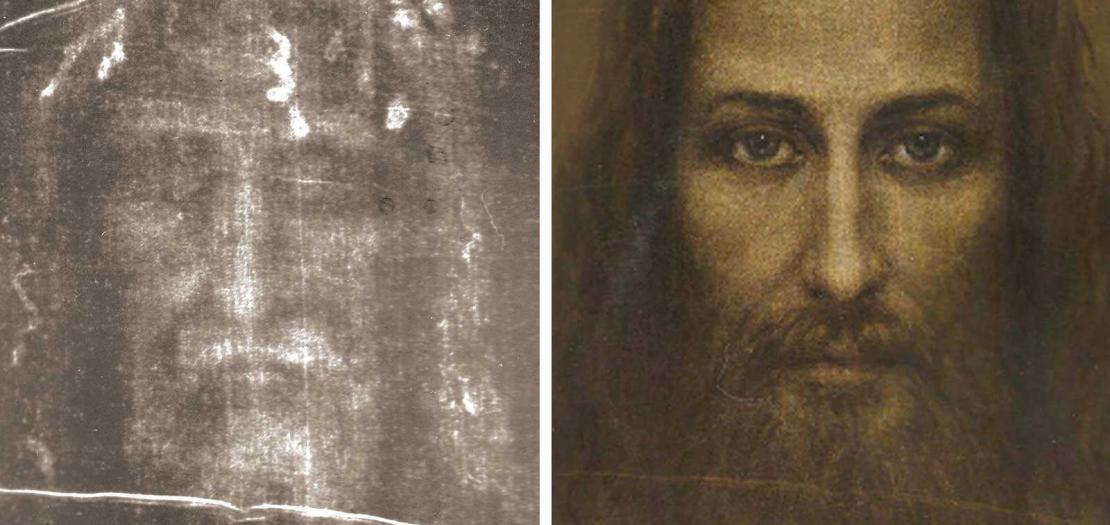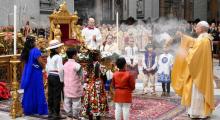Issued by the Catholic Center for Studies and Media - Jordan. Editor-in-chief Fr. Rif'at Bader - موقع أبونا abouna.org

New evidence indicates that the Turin Shroud is not a European forgery
New scientific tests conducted on the famous Shroud of Turin have revealed that the flax used to make the linen was grown in the Middle East.
The results of isotope tests provide new evidence that the shroud is the actual garment that was used to cover the body of Jesus Christ following his crucifixion – and is not a forgery that was created in medieval Europe. Fragments of cloth taken from the shroud show that its flax originated in the western Levant, a swathe of land occupied today by Israel, Lebanon and western parts of Jordan and Syria.
William Meacham, the American archaeologist who commissioned the study, said: “With a probable near Eastern origin, new doubts must be raised about interpreting the shroud as simply a fake relic made in medieval Europe, and new questions arise about what the image on the cloth signifies.
“The possibility that this cloth is actually the burial shroud of Jesus is strengthened by this new evidence. In my view, that remains the best explanation for the shroud.”
As a member of the board of directors of the Shroud of Turin Education and Research Association (STERA), Meacham obtained permission to test five of seven threads in the possession of the group.
The threads originated from a sample known as the “Raes piece” that was removed from the Shroud in 1973 for textile research.
Fourteen threads were provided by the Turin archdiocese to the physicist Ray Rogers, a member of the American scientific team that had conducted an onsite study of the shroud in 1978, and which were later passed on to STERA.
Testing was undertaken at the Stable Isotopes Laboratory of the University of Hong Kong, which is able to test very small samples of even less than 1mg.
Meacham said the Eastern origin of the shroud is important because “it reinforces other features that point in that direction”.
He explained: “Most notable was the pollen. Even though many identifications have since been discounted, certain species taken together still indicate an Eastern Mediterranean presence.
“Similarly, the crown of thorns [on the shroud] in helmet style rather than Roman circlet is a feature characteristic of Asia Minor and the Levant.
“Another is the claim of coins on the eyes in the shroud image that matched a documented instance from a second century burial in Judea.
“This was an impressive confirmation of a hypothesis generated by computer 3D analysis in 1977, at a time when there was no known instance (outside of Israel) of such a practice in antiquity.”
The shroud has been held in Turin, Italy since 1578, arriving from Chambery, France, where it had been kept since the 1350s.
It made a dramatic entrance on the European intellectual stage in 1898 when the first photographs were published, showing a lifelike facial image in the black and white photographic negative.
The shroud was studied in the mid-20th century by the French surgeon Pierre Barbet, who went on to write a book about the injuries of Christ’s passion called A Doctor at Calvary.
In 1978, a team of American scientists was granted a week-long onsite direct examination of the cloth and allowed to take sticky tape samples.
In the end, they were unable to explain what had caused the image, leaving a mystery that persists today, but their final report asserted that it had come from a human body.
In 1988, a sample was taken, divided into pieces and dated by three prominent laboratories to 1260-1390, results which cast grave doubt on the shroud’s authenticity. Further studies were not permitted by the Archdiocese of Turin.
Studies conducted in 2012 and 2015 on samples taken earlier found, however, that the linen sheet probably does date from the time of Jesus.
In 2017, a team from the Hospital University of Padua, Italy, led by Matteo Bevilacqua, conducted a forensic study of the imprint, and found it was of a person who suffered and died in exactly the same manner that Christ did as recorded in the Gospels.
Writing in the Open Journal of Trauma, the team speculated that the cause of death was a heart attack complicated by heart rupture through hemoperricardium in a subject crucified with the nailing of hands and feet.
They also saw signs of severe emotional stress and depression; severe hypovolemic-traumatic shock, acute respiratory failure at an early stage by crucifixion and causalgia [chronic pain in a limb]; blunt trauma following a fall, with paralysis of the entire right brachial plexus [shoulder nerves]; right shoulder dislocation, pulmonary contusion with hemothorax [lung injury], cardiac contusion [heart injury], probable left ulnar proximal paralysis and right foot dislocation from stretching during crucifixion.
The study inspired a 2022 paper by the Rev. Professor Patrick Pullicino, a priest in Southwark and formerly an NHS consultant neurologist, who proposed that the shoulder injury caused a huge internal bleed which resulted in the collapse of his circulatory system.
Up to three pints of blood spilled out from the cavity where the blood accumulated, he wrote in the Catholic Medical Quarterly, when the side of Jesus was speared by a Roman lance, as recorded in the Gospel of St John.
While the latest findings counter the accusation that the shroud is only a forgery, mystery remains and Meacham admits though that the carbon-dating of the shroud is “yet to be resolved” and that “there is slight overlap of a couple of samples (of flax) from western Europe with those of Israel”.






